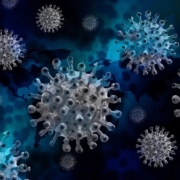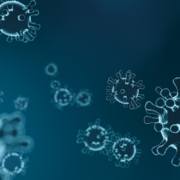Is Infection of Astrocytes a Causative Factor in COVID Brain Fog?
September 12, 2022

INTRODUCTION
One of the prominent symptoms of COVID-19, especially long COVID, is called “brain fog”, which includes deficits in attention and concentration, memory, and executive function. This raises the question of the cause. One possibility is that it is only an indirect effect from dysregulated immune activity and/or inflammation. A second possibility is that it is due to direct infection of cell populations within the brain. We will focus primarily on this second possibility, although they are not mutually exclusive.
ASTROCYTES
Attention has recently been brought to the potential role of astrocytes in COVID-19. Astrocytes provide physical support for neuronal synapses, as well as having numerous other functions. What is the evidence that astrocytes are being infected? What are the consequences of such infections? And what are the reasons for suspecting their infection might be related to the mental symptoms of long COVID?
Biochemical evidence of astrocyte injury has been a common finding in COVID-19 research. Further, among 26 people who died of COVID-19, 5 were found to have histopathological evidence of brain damage. All 5 yielded evidence of SARS-CoV-2 infection and replication in the brain, including viral double stranded RNA and spike protein. Infection was especially prevalent in astrocytes, suggesting a correlation between COVID-19 neurologic symptoms and infection of astrocytes. Moreover, neural stem cell-derived human astrocytes could be infected in vitro, after which they secreted factors affecting neuronal viability. Another study showed prominent infection of astrocytes in primary human cortical tissue in vitro. Interestingly, infection was not dependent upon ACE2, the main viral cell surface receptor, but was dependent upon two other proteins, basigin/CD147 and DPP4, both of which have been reported to be viral co-receptors. Infection induced expression of inflammatory factors, both in infected astrocytes as well as in bystander astrocytes.

If astrocytes indeed become infected during the course of COVID, how does the virus cross the blood-brain barrier? A possible route was identified in another recent in vitro that showed that pericyte-like cells, cultured in combination with cortical organoids, can be infected with SARS-CoV-2. The infected pericytes are then able to transmit virus to astrocytes and elicit a pro-inflammatory type I interferon response. Cortical organoids lacking pericytes were not infected. Pericytes are perivascular, making this a plausible route across the blood-brain barrier.
CONCLUSION
The studies referenced above indicate that astrocytes can and do become infected by SARS-CoV-2 (both in vitro and in vivo) and that infection leads to changes in astrocyte phenotype, including expression of pro-inflammatory factors. This makes it logical to suspect that this plays a role in the neurologic deficits often observed post-COVID-19, especially given the supporting role of astrocytes in neural synapses. It does not exclude the possibility that other factors such as systemic inflammation, auto immunity, or infection of other cells in the brain also play a role, and there are likely to be multiple mechanisms that may differ among individuals. Astrocytes may be affected by mechanisms other than direct infection, and individual cases of post-COVID-19 brain fog may not all be identical in their etiology. It will clearly be difficult to define the role of astrocyte infection in brain fog in humans. What is needed is an amenable animal model. And if astrocyte infection is indeed a key factor in COVID-19 brain fog, it is not clear what preventative or therapeutic modality might be successful beyond vaccination or early treatment of infection. The current treatments are various types of brain training and cognitive therapies, with improvement often noted. The big current question is how long brain fog will last, with hopes it is normally not permanent.
References
- . Ali, S.T., et al., Evolution of neurologic symptoms in non-hospitalized COVID-19 “long haulers”. Ann Clin Transl Neurol, 2022. 9(7): p. 950-961.
- Davis, H.E., et al., Characterizing long COVID in an international cohort: 7 months of symptoms and their impact. EClinicalMedicine, 2021. 38: p. 101019.
- Graham, E.L., et al., Persistent neurologic symptoms and cognitive dysfunction in non-hospitalized Covid-19 “long haulers”. Ann Clin Transl Neurol, 2021. 8(5): p. 1073-1085.
- Hampshire, A., et al., Cognitive deficits in people who have recovered from COVID-19. EClinicalMedicine, 2021. 39: p. 101044.
- Kanberg, N., et al., Neurochemical evidence of astrocytic and neuronal injury commonly found in COVID-19. Neurology, 2020. 95(12): p. e1754-e1759.
- Crunfli, F., et al., Morphological, cellular, and molecular basis of brain infection in COVID-19 patients. Proc Natl Acad Sci U S A, 2022. 119(35): p. e2200960119.
- Andrews, M.G., et al., Tropism of SARS-CoV-2 for human cortical astrocytes. Proc Natl Acad Sci U S A, 2022. 119(30): p. e2122236119.
- Li, Y., et al., The MERS-CoV Receptor DPP4 as a Candidate Binding Target of the SARS-CoV-2 Spike. iScience, 2020. 23(6): p. 101160.
- Wang, K., et al., CD147-spike protein is a novel route for SARS-CoV-2 infection to host cells. Signal Transduct Target Ther, 2020. 5(1): p. 283.
- Wang, L., et al., A human three-dimensional neural-perivascular ‘assembloid’ promotes astrocytic development and enables modeling of SARS-CoV-2 neuropathology. Nat Med, 2021. 27(9): p. 1600-1606.
